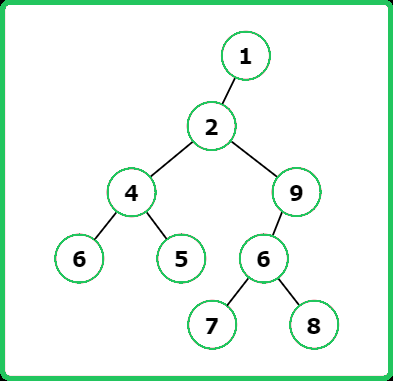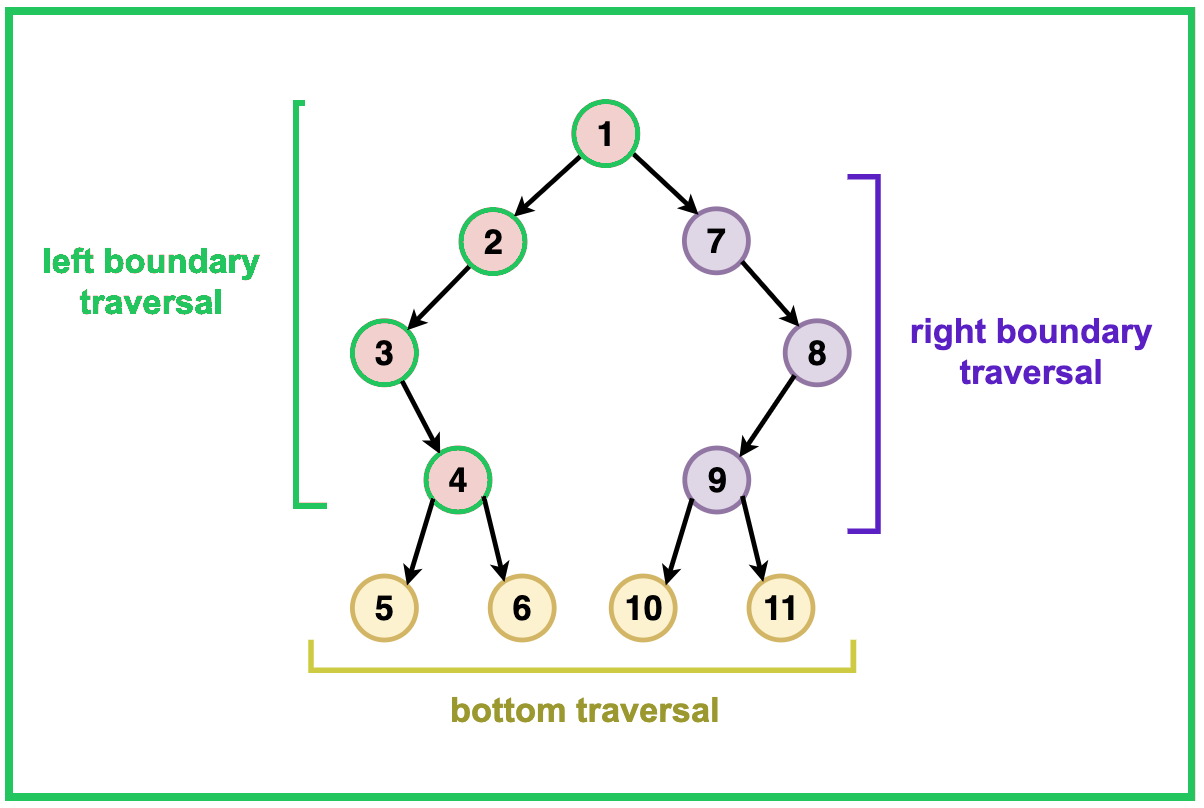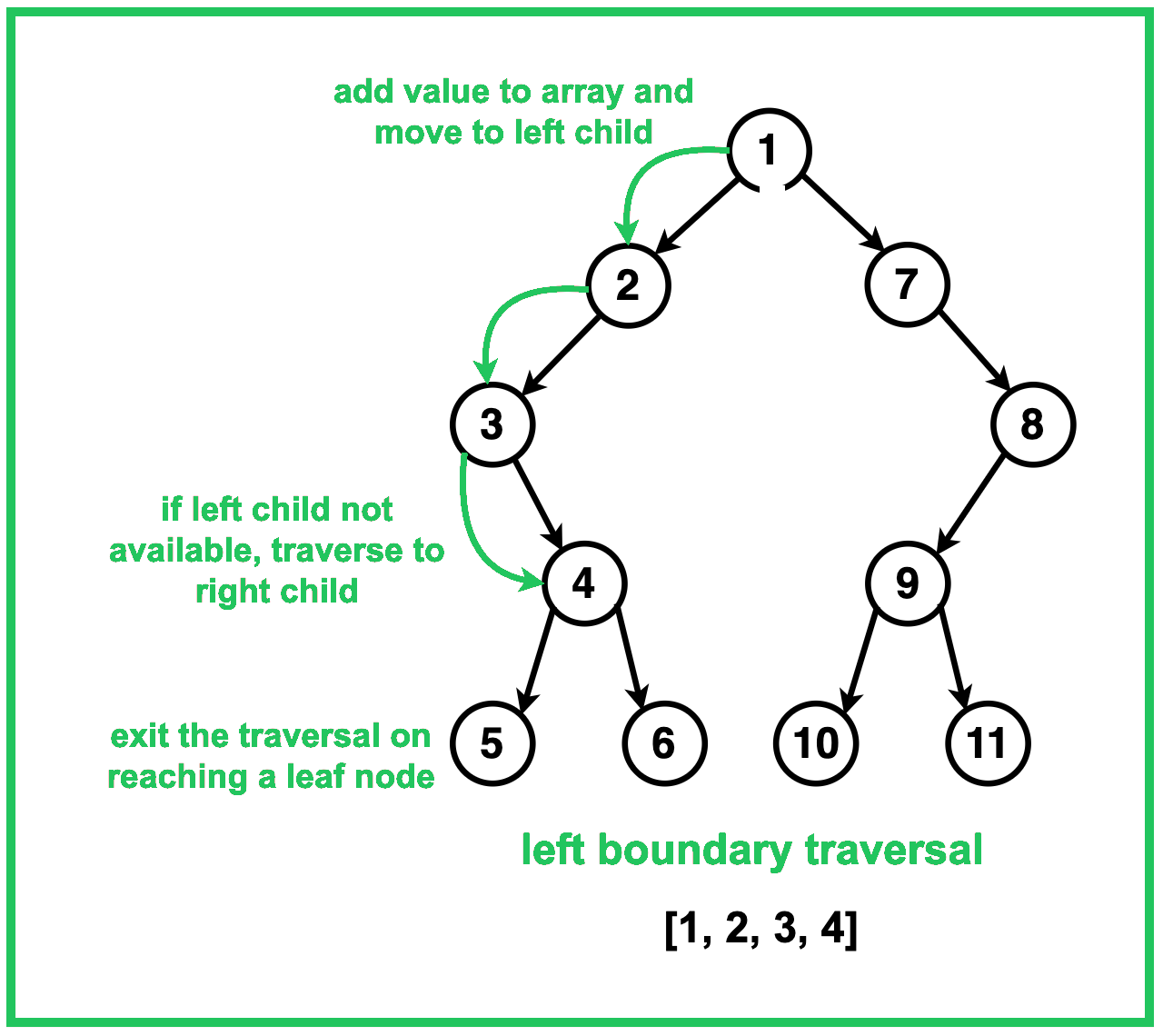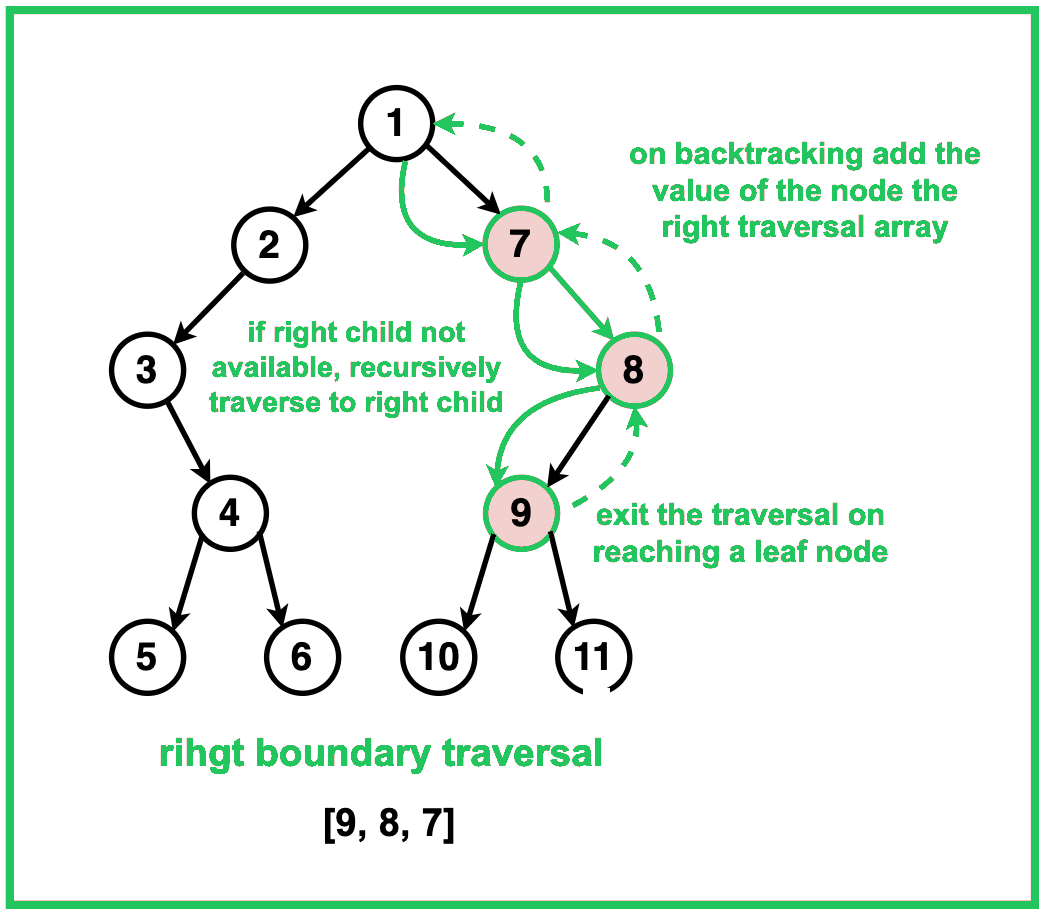123456789101112131415161718192021222324252627282930313233343536373839404142434445464748495051525354555657585960616263646566676869707172737475767778798081828384858687888990919293949596979899100101102103104105106107108109110111112113114115116
#include <bits/stdc++.h>
using namespace std;
/**
* Definition for a binary tree node.
* struct TreeNode {
* int data;
* TreeNode *left;
* TreeNode *right;
* TreeNode(int val) : data(val), left(nullptr), right(nullptr) {}
* };
**/
class Solution {
public:
// Function to check if a node is a leaf
bool isLeaf(TreeNode* root) {
return !root->left && !root->right;
}
// Function to add the left boundary of the tree
void addLeftBoundary(TreeNode* root, vector<int>& res) {
TreeNode* curr = root->left;
while (curr) {
if (!isLeaf(curr)) {
res.push_back(curr->data);
}
if (curr->left) {
curr = curr->left;
} else {
curr = curr->right;
}
}
}
// Function to add the right boundary of the tree
void addRightBoundary(TreeNode* root, vector<int>& res) {
TreeNode* curr = root->right;
vector<int> temp;
while (curr) {
if (!isLeaf(curr)) {
temp.push_back(curr->data);
}
if (curr->right) {
curr = curr->right;
} else {
curr = curr->left;
}
}
for (int i = temp.size() - 1; i >= 0; --i) {
res.push_back(temp[i]);
}
}
// Function to add the leaves of the tree
void addLeaves(TreeNode* root, vector<int>& res) {
if (isLeaf(root)) {
res.push_back(root->data);
return;
}
if (root->left) {
addLeaves(root->left, res);
}
if (root->right) {
addLeaves(root->right, res);
}
}
// Main function to perform the boundary traversal of the binary tree
vector<int> boundary(TreeNode* root) {
vector<int> res;
if (!root) {
return res;
}
if (!isLeaf(root)) {
res.push_back(root->data);
}
addLeftBoundary(root, res);
addLeaves(root, res);
addRightBoundary(root, res);
return res;
}
};
// Helper function to print the result
void printResult(const vector<int>& result) {
for (int val : result) {
cout << val << " ";
}
cout << endl;
}
int main() {
// Creating a sample binary tree
TreeNode* root = new TreeNode(1);
root->left = new TreeNode(2);
root->right = new TreeNode(3);
root->left->left = new TreeNode(4);
root->left->right = new TreeNode(5);
root->right->left = new TreeNode(6);
root->right->right = new TreeNode(7);
Solution solution;
// Get the boundary traversal
vector<int> result = solution.boundary(root);
// Print the result
cout << "Boundary Traversal: ";
printResult(result);
return 0;
}
123456789101112131415161718192021222324252627282930313233343536373839404142434445464748495051525354555657585960616263646566676869707172737475767778798081828384858687888990919293949596979899100101102103104105106107108109110
/**
* Definition for a binary tree node.
* public class TreeNode {
* int data;
* TreeNode left;
* TreeNode right;
* TreeNode(int val) { data = val; left = null, right = null; }
* }
**/
class Solution {
// Function to check if a node is a leaf
public boolean isLeaf(TreeNode root) {
return root.left == null && root.right == null;
}
// Function to add the left boundary of the tree
public void addLeftBoundary(TreeNode root, List<Integer> res) {
TreeNode curr = root.left;
while (curr != null) {
if (!isLeaf(curr)) {
res.add(curr.data);
}
if (curr.left != null) {
curr = curr.left;
} else {
curr = curr.right;
}
}
}
// Function to add the right boundary of the tree
public void addRightBoundary(TreeNode root, List<Integer> res) {
TreeNode curr = root.right;
List<Integer> temp = new ArrayList<>();
while (curr != null) {
if (!isLeaf(curr)) {
temp.add(curr.data);
}
if (curr.right != null) {
curr = curr.right;
} else {
curr = curr.left;
}
}
for (int i = temp.size() - 1; i >= 0; --i) {
res.add(temp.get(i));
}
}
// Function to add the leaves of the tree
public void addLeaves(TreeNode root, List<Integer> res) {
if (isLeaf(root)) {
res.add(root.data);
return;
}
if (root.left != null) {
addLeaves(root.left, res);
}
if (root.right != null) {
addLeaves(root.right, res);
}
}
// Main function to perform the boundary traversal of the binary tree
public List<Integer> boundary(TreeNode root) {
List<Integer> res = new ArrayList<>();
if (root == null) {
return res;
}
if (!isLeaf(root)) {
res.add(root.data);
}
addLeftBoundary(root, res);
addLeaves(root, res);
addRightBoundary(root, res);
return res;
}
// Helper function to print the result
public static void printResult(List<Integer> result) {
for (int val : result) {
System.out.print(val + " ");
}
System.out.println();
}
public static void main(String[] args) {
// Creating a sample binary tree
TreeNode root = new TreeNode(1);
root.left = new TreeNode(2);
root.right = new TreeNode(3);
root.left.left = new TreeNode(4);
root.left.right = new TreeNode(5);
root.right.left = new TreeNode(6);
root.right.right = new TreeNode(7);
Solution solution = new Solution();
// Get the boundary traversal
List<Integer> result = solution.boundary(root);
// Print the result
System.out.print("Boundary Traversal: ");
printResult(result);
}
}
123456789101112131415161718192021222324252627282930313233343536373839404142434445464748495051525354555657585960616263646566676869707172737475767778798081828384
# Definition for a binary tree node.
# class TreeNode(object):
# def __init__(self, val=0, left=None, right=None):
# self.data = val
# self.left = left
# self.right = right
class Solution:
# Function to check if a node is a leaf
def isLeaf(self, root):
return not root.left and not root.right
# Function to add the left boundary of the tree
def addLeftBoundary(self, root, res):
curr = root.left
while curr:
if not self.isLeaf(curr):
res.append(curr.data)
if curr.left:
curr = curr.left
else:
curr = curr.right
# Function to add the right boundary of the tree
def addRightBoundary(self, root, res):
curr = root.right
temp = []
while curr:
if not self.isLeaf(curr):
temp.append(curr.data)
if curr.right:
curr = curr.right
else:
curr = curr.left
res.extend(temp[::-1])
# Function to add the leaves of the tree
def addLeaves(self, root, res):
if self.isLeaf(root):
res.append(root.data)
return
if root.left:
self.addLeaves(root.left, res)
if root.right:
self.addLeaves(root.right, res)
# Main function to perform the boundary traversal of the binary tree
def boundary(self, root):
res = []
if not root:
return res
if not self.isLeaf(root):
res.append(root.data)
self.addLeftBoundary(root, res)
self.addLeaves(root, res)
self.addRightBoundary(root, res)
return res
# Helper function to print the result
def printResult(result):
for val in result:
print(val, end=" ")
print()
# Creating a sample binary tree
root = TreeNode(1)
root.left = TreeNode(2)
root.right = TreeNode(3)
root.left.left = TreeNode(4)
root.left.right = TreeNode(5)
root.right.left = TreeNode(6)
root.right.right = TreeNode(7)
solution = Solution()
# Get the boundary traversal
result = solution.boundary(root)
# Print the result
print("Boundary Traversal: ", end="")
printResult(result)
123456789101112131415161718192021222324252627282930313233343536373839404142434445464748495051525354555657585960616263646566676869707172737475767778798081828384858687888990919293949596979899100101102103104105106107108
/**
* Definition for a binary tree node.
* class TreeNode {
* constructor(val = 0, left = null, right = null){
* this.data = val;
* this.left = left;
* this.right = right;
* }
* }
**/
class Solution {
// Function to check if a node is a leaf
isLeaf(root) {
return !root.left && !root.right;
}
// Function to add the left boundary of the tree
addLeftBoundary(root, res) {
let curr = root.left;
while (curr) {
if (!this.isLeaf(curr)) {
res.push(curr.data);
}
if (curr.left) {
curr = curr.left;
} else {
curr = curr.right;
}
}
}
// Function to add the right boundary of the tree
addRightBoundary(root, res) {
let curr = root.right;
const temp = [];
while (curr) {
if (!this.isLeaf(curr)) {
temp.push(curr.data);
}
if (curr.right) {
curr = curr.right;
} else {
curr = curr.left;
}
}
for (let i = temp.length - 1; i >= 0; --i) {
res.push(temp[i]);
}
}
// Function to add the leaves of the tree
addLeaves(root, res) {
if (this.isLeaf(root)) {
res.push(root.data);
return;
}
if (root.left) {
this.addLeaves(root.left, res);
}
if (root.right) {
this.addLeaves(root.right, res);
}
}
// Main function to perform the boundary traversal of the binary tree
boundary(root) {
const res = [];
if (!root) {
return res;
}
if (!this.isLeaf(root)) {
res.push(root.data);
}
this.addLeftBoundary(root, res);
this.addLeaves(root, res);
this.addRightBoundary(root, res);
return res;
}
}
// Helper function to print the result
function printResult(result) {
for (const val of result) {
console.log(val);
}
}
// Creating a sample binary tree
const root = new TreeNode(1);
root.left = new TreeNode(2);
root.right = new TreeNode(3);
root.left.left = new TreeNode(4);
root.left.right = new TreeNode(5);
root.right.left = new TreeNode(6);
root.right.right = new TreeNode(7);
const solution = new Solution();
// Get the boundary traversal
const result = solution.boundary(root);
// Print the result
console.log("Boundary Traversal: ");
printResult(result);





